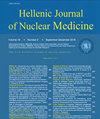PET/CT:淋巴瘤的临床作用。
摘要
18F-FDG PET/CT是大多数淋巴瘤准确初始分期的首选成像方式。霍奇金淋巴瘤、弥漫性大B细胞淋巴瘤和滤泡性淋巴瘤表现出强烈的FDG摄取,而少数非霍奇金淋巴瘤亚型,即MALT、边缘和小淋巴细胞淋巴瘤表现出低或中度亲合力。根据经验,惰性淋巴瘤表现出比侵袭性淋巴瘤更低的FDG活性。PET/CT在检测淋巴结受累方面具有更高的灵敏度,即使在小的或正常大小的淋巴结中也是如此。在淋巴结外疾病的检测中,它显示出比CT更高的灵敏度,最常见的是在脾脏和骨髓中。PET/CT可导致高达25%的霍奇金淋巴瘤发病,为强化治疗铺平道路。它在检测霍奇金病骨髓受累方面具有极好的阴性预测价值(NPV>95%),这使得骨髓活检不是绝对必要的:阴性PET排除了霍奇金病患者的骨髓疾病,但这并不普遍适用于非霍奇金淋巴瘤。PET/CT在侵袭性非霍奇金淋巴瘤的初步诊断中优于其他成像方式,在以前未怀疑或隐匿的部位检测疾病。18F-FDG PET/CT通过在2-3个初始化疗周期后进行的中期PET应用于霍奇金病的早期治疗评估。中期PET阴性且未发现高代谢性疾病的患者可以继续接受同样有效的治疗或改用不那么积极的治疗。另一方面,没有表现出PET反应的患者可能会接受更强化的治疗,以根除高代谢活动性疾病。随机对照试验已经证明,中期PET/CT对霍奇金病的最终治疗反应和增加无进展生存率显示出高NPV。通过应用特定的客观标准:多维尔5核量表,报告和解释治疗中期和治疗后PET/CT的准确性有所提高。多维尔的摄取分数为4-5,比肝脏活动更强烈,相当于活动性淋巴瘤。病变中18F-FDG摄取量等于或低于纵隔血池,被解释为阴性:多维尔评分为1-2。临时PET在非霍奇金淋巴瘤中的作用也得到了研究,尤其是在目前应用更有效的治疗方法的情况下。强烈推荐PET/CT用于淋巴瘤的治疗后评估,与CT相比,PET/CT具有优异的NPV和更高的诊断准确性。治疗后,很大一部分患者在CT上显示出残余解剖损伤,例如残余纵隔软组织;然而,在少数病例中,这些病变对应于活动性疾病。PET/CT在评估残余组织方面具有较高的诊断准确性,并且可以区分PET阴性的纤维化或坏死组织和PET阳性的活动性残余疾病。该模式在评估干细胞移植前的超治疗时也具有高NPV:良好的PET反应与更好的无进展生存率和总生存率相关。总之,PET/CT已经发展成为淋巴瘤患者的一种既定方法,并被纳入改变治疗决策的临床算法和指南中。18F-FDG PET/CT is the imaging modality of choice for the accurate initial staging of most lymphomas. Hodgkin's, Diffuse Large B-cell and follicular lymphomas show avid FDG uptake, while a minority of Non-Hodgkin lymphoma subtypes namely MALT, marginal and small lymphocytic lymphoma demonstrate low or moderate avidity. As a rule of thumb, indolent lymphomas show lower FDG activity than aggressive ones. PET/CT has increased sensitivity in the detection of nodal involvement even in small or normal-sized nodes. It shows higher sensitivity than CT in the detection of extra-nodal disease, most often in the spleen and bone marrow. PET/CT leads to upstaging in up to 25% of Hodgkin lymphomas, paving the way to intensified therapy. It has excellent Negative Predictive Value (NPV>95%) in the detection of bone marrow involvement in Hodgkin's rendering bone marrow biopsy not absolutely necessary: a negative PET rules out bone marrow disease in Hodgkin's patients, yet this does not universally apply in Non-Hodgkin lymphomas. PET/CT is superior to other imaging modalities in the initial stating of aggressive Non-Hodgkin lymphomas detecting disease in previously not suspected or occult sites. 18F-FDG PET/CT is applied in the early therapeutic evaluation of Hodgkin's by means of interim PET performed after 2-3 initial cycles of chemotherapy. Patients with negative interim PET and no hypermetabolic disease identified may continue with the same effective treatment or switch to less aggressive therapy. On the other hand, patients who do not show PET response may be subjected to more intensified treatment to eradicate hypermetabolic active disease. Randomized controlled trials have proven that interim PET/CT shows high NPV for final treatment response and for increased progression free survival in Hodgkin's. The accuracy in reporting and interpretating interim and post-treatment PET/CT has increased by applying specific objective criteria: Deauville 5-score scale. Deauville's uptake scores of 4-5, more intense than liver activity, correspond to active lymphomatous disease. 18F-FDG uptake in lesions, equal or lower than mediastinal blood-pool, is interpreted as negative: Deauville scores of 1-2. Role of interim PET is also investigated in Non-Hodgkin Lymphomas, especially nowadays with more effective treatments being applied. PET/CT is highly recommended for post-treatment assessment of lymphomas with excellent NPV and superior diagnostic accuracy compared with CT. After treatment, a significant proportion of patients show residual anatomic lesions on CT f.e. residual mediastinal soft-tissue; yet, in the minority of cases, these lesions correspond to active disease. PET/CT has high diagnostic accuracy in the assessment of residual tissue and may distinguish between PET-negative fibrotic or necrotic tissue and PET-positive, active residual disease. The modality also has high NPV in the evaluation of megatherapy before stem cell transplantation: a favorable PET response is associated with better progression free survival and overall survival. To sum up, PET/CT has evolved as an established method in lymphoma patients being incorporated into clinical algorithms and guidelines altering therapeutic decisions.

 求助内容:
求助内容: 应助结果提醒方式:
应助结果提醒方式:


